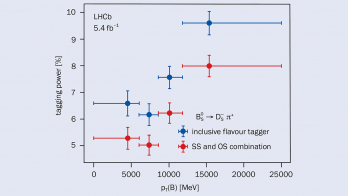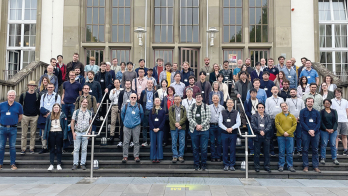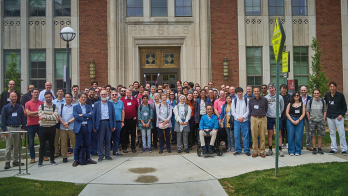The MEG II experiment is preparing to probe the muon’s flavour-violating decay to a positron and a photon with unprecedented sensitivity.
Searching for the decay μ+ → e+γ is like looking for a needle in a haystack the size of the Great Pyramid of Giza. This simile-stretching endeavour is the task of the MEG II experiment at the Paul Scherrer Institute (PSI) in Villigen, Switzerland. MEG II is an upgrade of the previous MEG experiment, which operated from 2008 to 2013. All experimental data so far are consistent with muon decays that conserve lepton flavour by the production of two appropriately flavoured neutrinos. Were MEG II to observe the neutrinoless decay of the muon to a positron and a photon, it would be the first evidence of flavour violation with charged leptons, and unambiguous evidence for new physics.
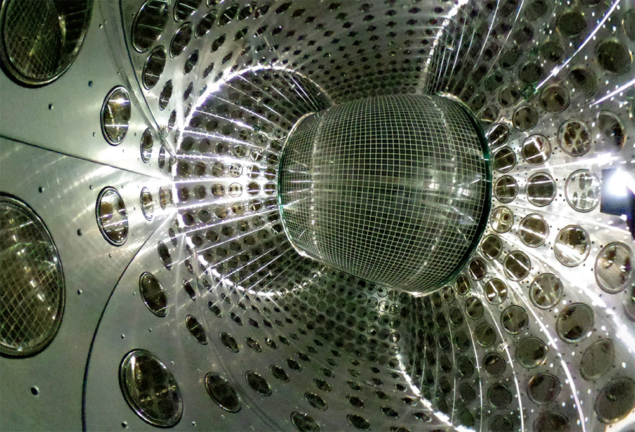
Lepton-flavour conservation is a mainstay of every introductory particle-physics course, yet it is merely a so-called accidental symmetry of the Standard Model (SM). Unlike gauge symmetries, it arises because only massless left-handed neutrinos are included in the model. The corresponding mass and interaction terms of the Lagrangian can therefore be simultaneously diagonalised, which means that interactions always conserve lepton flavour. This is not the case in the quark sector, and as a result quark flavour is not conserved in weak interactions. Since lepton flavour is not considered to be a fundamental symmetry, most extensions of the SM predict its violation at a level that could be observed by state-of-the-art experiments.
Indeed an extension of the SM is already required to include the tiny neutrino masses that we infer from neutrino oscillations. In this extension, neutrino oscillations induce charged lepton-flavour-violating processes but with the branching ratio for μ+ → e+γ emerging to be only 10–54, which cannot be accessed experimentally (see “Charged lepton-flavour violation in the SM” box). A data sample of muons as large as the number of protons in the Earth would not be enough to see such an improbable decay. Charged lepton-flavour violation is therefore a clear signature of new physics with no SM backgrounds.
Finding the needle
The search requires an intense source of muons, and detectors capable of reconstructing the kinematics of the muon’s decay products with high precision. PSI offers the world’s most intense continuous muon beams, delivering up to 108 muons per second. MEG II (previously as MEG) is designed to search for μ+ → e+γ by stopping positive muons on a thin target, and looking for positron–photon pairs from muon decays at rest. This method exploits the two-body kinematics of the decay to discriminate signal events from the backgrounds, which are predominantly the radiative muon decay μ+ → e+ νe ν̅μ γ and the accidental time coincidence of a positron and photon produced by different muon decays.
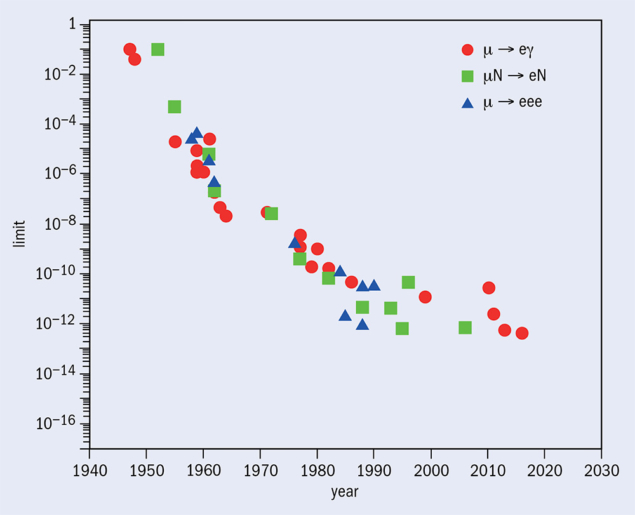
In the late 1990s, when the first MEG experiment was being designed, theorists argued that the μ+ → e+γ branching ratio could be as high as 10–12 to 10–14, based on supersymmetry arising at the TeV scale. Twenty years later, MEG has excluded branching ratios above 4.2 × 10–13 (figure 1), and supersymmetric particles remain undiscovered at the LHC. Nevertheless, since charged lepton-flavour-violating processes are sensitive to the virtual exchange of new particles, while not requiring their creation as at the LHC, they can probe new physics models (supersymmetry, extra dimensions, leptoquarks, multi-Higgs, etc) up to mass scales of thousands of TeV. Scales such as these are not only unreachable at the LHC, but also at near-future accelerators.
The MEG collaboration therefore decided to upgrade the detectors with the goal of improving the sensitivity of the experiment by a factor of 10. The new experiment, which adopts the same measurement principle, is expected to start taking data at the end of 2019 (figure 2). Photons are reconstructed by a liquid xenon (LXe) detector technology that was pioneered by the MEG collaboration, achieving an unprecedented ~2% calorimetric resolution at energies as low as 52.8 MeV – the energy of the photon in a μ+ → e+γ decay. The LXe detector provides a high-resolution measurement of the position and timing of the photon conversion, precise to a few millimetres and approximately 70 ps. The positrons are reconstructed in a magnetic spectrometer instrumented with drift chambers for tracking, and scintillator bars for timing. A peculiarity of the MEG spectrometer is a non-uniform magnetic field, diminishing from 1.2 T at the centre of the detector to 0.5 T at the extremities. The gradated field prevents positrons from curling too many times. This avoids pileup in the detectors and makes positrons of the same momentum curl with the same radius, independent of their emission angle, thus simplifying the design and operation of the tracking system.
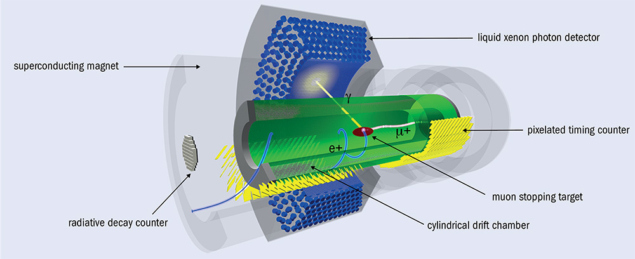
Following a major overhaul that was begun in 2011, all the detectors have now been upgraded. Silicon photomultipliers custom-modified for sensitivity to the ultraviolet LXe scintillation light have replaced conventional photomultipliers on the inner face of the calorimeter. Small scintillating tiles have replaced the scintillating bars of the positron-timing detector to improve timing and reduce pileup. The main challenge when upgrading the drift chambers was dealing with high positron rates. Here, the need for high granularity had to be balanced by keeping the total amount of material low. This reduces both multiple scattering and the rate of positrons annihilating in the material, and contributions to the coincident-photon background in the calorimeter. The solution was the use of extremely thin 40 and 50 μm silver-plated aluminium wires, 20 μm gold-plated tungsten wires, and innovative assembly techniques. All the detectors’ resolutions were improved by a factor of around two with respect to the MEG experiment. The MEG II design also includes a new detector to veto photons coming from radiative muon decays, improved calibration tools and new trigger and data-acquisition electronics to cope with the increased number of readout channels. The improved detector performance will allow the muon beam rate to be more than doubled, from 3.3 × 107 to 7 × 107 muons per second.
The detectors were installed and tested in the muon beam in 2018. In 2019 a test of the whole detector will be completed, with the possibility of collecting the first physics data. The experiment is then expected to run for three years to uncover evidence for the μ+ → e+γ decay if the branching ratio is around 10–13 or set a limit of 6 × 10–14 on its branching ratio.
Charged lepton-flavour violation in the SM – a very small neutrino oscillation experiment
 The presence of only massless left-handed neutrinos in the Standard Model (SM) gives rise to the accidental symmetry of lepton-flavour conservation – yet neutrino oscillation experiments have observed neutrinos changing flavour in-transit from sources as far away as the Sun and as near as a nuclear reactor. Such neutral lepton-flavour violation implies that neutrinos have tiny masses and that their flavour eigenstates are distinct from their mass eigenstates. Phases develop between the mass eigenstates as a neutrino travels, and the wavefunction becomes a mixture of the flavour eigenstates, rather than the unique original flavour, as would remain the case for truly massless neutrinos.
The presence of only massless left-handed neutrinos in the Standard Model (SM) gives rise to the accidental symmetry of lepton-flavour conservation – yet neutrino oscillation experiments have observed neutrinos changing flavour in-transit from sources as far away as the Sun and as near as a nuclear reactor. Such neutral lepton-flavour violation implies that neutrinos have tiny masses and that their flavour eigenstates are distinct from their mass eigenstates. Phases develop between the mass eigenstates as a neutrino travels, and the wavefunction becomes a mixture of the flavour eigenstates, rather than the unique original flavour, as would remain the case for truly massless neutrinos.
The effect on charged lepton-flavour violation is subtle and small. In most neutrino oscillation experiments, a neutrino is created in a charged-current interaction and observed in a later interaction via the creation of a charged lepton of the corresponding flavour in the detector.
μ+ → e+γ may proceed in a similar way, but where the same W boson is involved in both the creation and destruction of the neutrino, and the neutrino oscillates in between (see figure above).
In this process, the neutrino oscillation ν̅μ → ν̅e has to occur at an energy scale E ~ mw, over an extremely short distance of L ~ 1/mw. Considering only two neutrino species with masses m1 and m2, the probability for the oscillation is proportional to sin2 [(m21 – m22) L /4E]. Hence, the μ → eγ branching ratio is suppressed by the tiny factor (m21 – m22)/m2w)2 ≲ 10–49. The exact calculation, including the most recent estimates of the neutrino mixing matrix elements, gives BR(μ → eγ) ~ 10–54.
New directions
In the meantime, PSI researchers are investigating the possibility of building new beamlines with 109 or even 1010 muons per second to allow experimenters to probe even smaller branching ratios. How could a future experiment cope with such high rates? Preliminary studies are investigating a system where photons are converted into pairs of electrons and positrons, and reconstructed in a tracking device. This solution, which has already been exploited previously by the MEGA experiment at Los Alamos National Laboratory, could also improve the photon resolution.
At the same time, other experiments are searching for charged lepton-flavour violation in other channels. Mu3e, also at PSI, will search for μ+ → e+e+e– decays. The Mu2e and COMET experiments, at Fermilab and J-PARC, respectively, will search for muon-to-electron conversion in the field of a nucleus. These processes are complementary to μ+ → e+γ, allowing alternative scenarios to be probed. At the same time, collider experiments such as Belle II and LHCb are working on studies of lepton-flavour violation in tau decays. LHCb researchers are also testing lepton universality, which holds that the weak couplings are the same for each lepton flavour (see The flavour of new physics). As theorists often stress, all these analyses are strongly complementary both with each other and with direct searches for new particles at the LHC.
Ever since the pioneering work of Conversi, Pancini and Piccioni, muons have played a crucial role in the development of particle physics. When I I Rabi exclaimed “who ordered that?”, he surely did not imagine that 80 years later the lightest unstable elementary particle would still be a focus of cutting-edge research.
Further reading
MEG Collaboration 2016 Eur. Phys. J. C 76 434.
MEG II Collaboration 2018 Eur. Phys. J. C 78 380.
L Calibbi and G Signorelli 2018 Riv. Nuovo Cimento 41 71.






